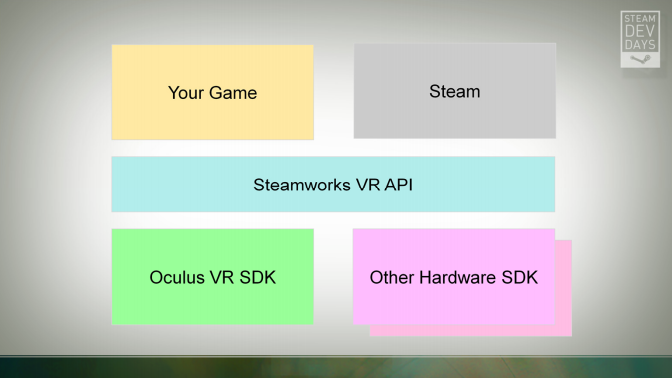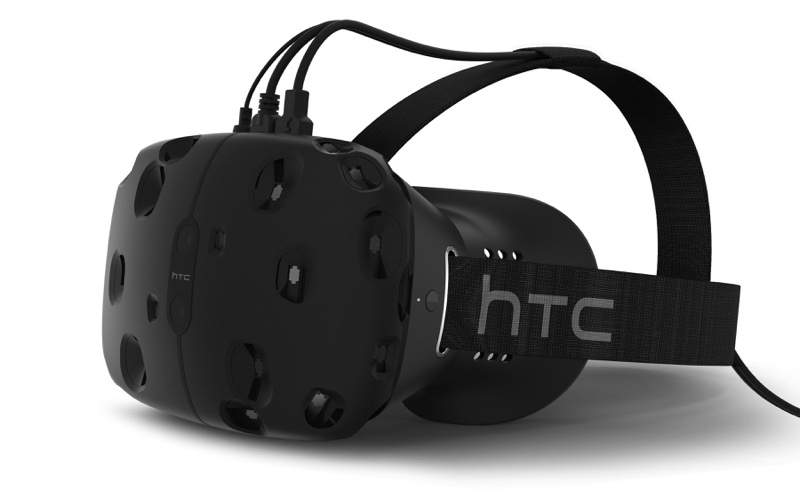There's a lot of SteamVR news going around, and with that news also some misinformation. We've written this article to expand on the history of the platform and hopefully clear up some things about it. Keep in mind we're not affiliated with Valve and even though most of the information in this post is compiled from official sources, there will be some speculation in the second paragraph.
If there's any more SteamVR news at GDC we'll be sure to add it to this post. Chet Faliszek also has a talk and Q&A on SteamVR at EGX Rezzed next week (Friday 13 March), we'll be adding any new information from that talk to this post as well. Chet's EGX event is streamed here and will be available after the event here.
What we know
SteamVR
On October 29th 2013 Valve released an app named "OpenVR". While it initially shipped with Oculus Rift DK1 support, there were also references to it supporting something named "Vortex" but support for this was not present in the released version.
On January 13th 2014 Valve rebranded OpenVR into SteamVR and released a "VR (Virtual Reality) mode" for the Steam Client.
3 days later during the Steam Dev Days, Valve's Michael Abrash (before he moved to Oculus) gave a presentation on "What VR Could, Should and Almost Certainly Will Be within Two Years" in which he discussed and showed a picture of Valve's then current prototype HMD (Head Mounted Display) VR prototype and explained what would be needed to get to a feasible consumer HMD in 2015. He also said Valve isn't looking to bring a consumer product to the market just yet. More on these things later.
Valve's Joe Ludwig also had a talk at the Steam Dev Days in which he talked about the combination of Steam and VR. They developed a layer between the game and the drivers for VR head mounted displays (HMDs). This is SteamVR, formerly OpenVR.

All developers with games on Steam are able to implement the Steamworks VR API. Implementing this API and shipping their game in combination with SteamVR support means their game supports any HMD that Valve has added support for to SteamVR's platform.
Some developers have already implemented SteamVR support, here's a list of some of the apps that are currently shipping (or working on) a SteamVR implementation:
- Half-Life 2, Episode One, Episode Two and Lost Coast.
- Half-Life: Source
- Team Fortress 2
- Euro Truck Simulator 2
- World of Diving
- Axis Game Factory's AGFPRO 2.0
- Calibre 10 Racing Series
- Shadow Ops: Red Mercury
- Pro Evolution Soccer 2015
- Strike Suit Zero: Director's Cut
- FINAL FANTASY XIII-2
- Paradigm Shift
- MotorSport Revolution
- Ascension
- Pro Evolution Soccer 2015 Demo
- Robotex
- Radial-G : Racing Revolved
- Tkl Online
- Hollow's Land
- INIT.
Upcoming SteamVR titles announced together with the HTC Vive, these are likely all to be made specifically for VR:
- Job Simulator by Owlchemy Labs.
- TheBluVR: Encounter For Vive by WEVR
- The Gallery by Cloudhead Games
- Tilt Brush by Skillman & Hackett
- Unannounced demo experience by Bossa Studios
- Unannounced project by Vertigo Games
- Seen any other announcements mentioning SteamVR support? Leave a comment!
HTC Vive
The first HMD that was developed together with Valve was announced at the Mobile World Congress during a HTC media briefing. It's called the HTC Vive. You can find the official website here.
Here's what we currently know about it:
- Built on the SteamVR platform
- 90Hz low persistence global display
- 1080x1200 resolution per eye, framebuffer of 2160x1200
- "Custom" ergonomic dual-wield controllers with position tracking made specifically for VR by HTC
- 110° field of view
- 360° rotational tracking to a 1/10th degree accuracy (the lasers HTC mentioned are not on the headset)
- (Optional) base stations for accurate positional tracking in a (up to) 15 by 15 feet (4.5 meter) room.

Coming back to Michael Abrash's earlier mentioned talk and his expectations for a feasible HMD in 2015 it seems the currently announced specs of the HTC Vive are very close to being exactly what Abrash expected. He mentions a little less than 90Hz might still be okay. We don't know the other specs yet, but it looks like this is very close to what he predicted.
SteamVR currently only supports the Oculus Rift devkits, but support for the HTC Vive is probably coming in a SteamVR update soon.
What we expect
More headsets
Even though the HTC Vive was created together with Valve, we think there's a good chance that there will be more headsets in the future that support SteamVR (or the other way around, SteamVR supporting the headset). Probably nothing on this front during GDC, though!
Launch title
Many are speculating whether or not Valve will attach a launch title to the HTC Vive. While I personally don't think this will happen, if it's any title it'll probably be L4D3 and not HL3.
Deeper API
SteamVR only has basic functionality for interacting with VR HMDs. There is no functionality for input, audio and advanced features such as time warp that the Oculus Rift SDK exposes. If Valve wants SteamVR to be what game developers implement in their games they should expand the reach of the API to cover additional functionality. But, seeing how such advanced features might be patented by said HMD creators it might not be as easy for Valve to add these to SteamVR. Only time will tell how/if they'll tackle these issues.
